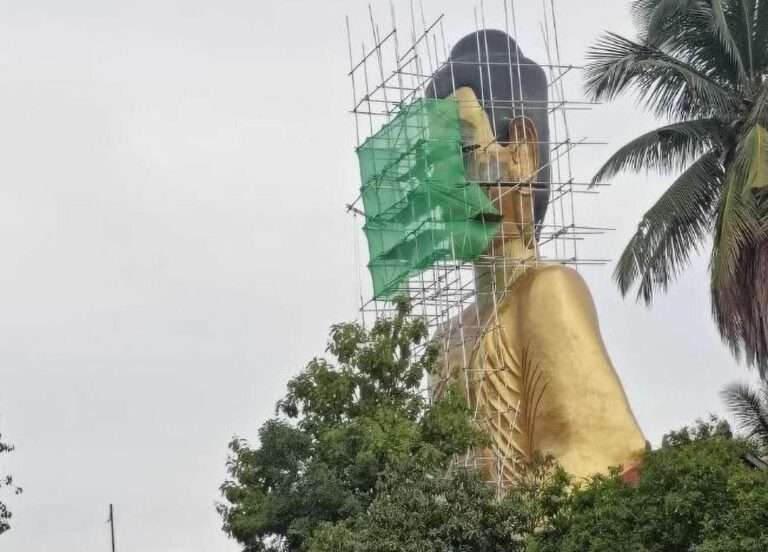A decapitated Egyptian mummy‘s head discovered in an attic in Kent, in the United Kingdom, has undergone a state-of-the-art CT scan to try and uncover its secrets.
The head, which is at least 2,000 years old, was thought to have been brought to the U.K. from Egypt as a souvenir in the 19th century and given to the owner in the early 20th century.
It was discovered in a glass case during a clear-out after the death of a man in Ramsgate.
The head, minus any wrappings or its body, was inherited by the man’s brother who took it along to the Canterbury Museums and Galleries.
Initial X-rays undertaken at Canterbury Christ Church University suggested it was an adult female, however a detailed CT scan was organized to learn more about the individual.
Preliminary results from the scan, carried out at Maidstone Hospital, indicate that the brain has been removed, the teeth are well worn down by a rough diet and that the tongue shows remarkable preservation.
There appears to be tubing of unknown material within the left nostril and in the spinal canal. Whether this is of ancient or more recent origin, is unknown.

The team are hoping to eventually recreate the face of the mysterious mummy and reconstruct the hidden history of the individual.
The scan was led by James Elliott, senior radiographer at Maidstone and Tunbridge Wells NHS Trust and also lecturer in diagnostic radiography at Canterbury Christ Church University.
Mr. Elliott, who is an expert in forensic radiography with a background in archaeology, said: “During the Victorian times items like this used to be brought back from Egypt as souvenirs and may well have been passed down through generations to the person who owned it.
“The scan provides a huge amount of information – everything from dental status, pathologies, method of preservation as well as helping our estimations of age and sex.
“We plan on using the scanning data to create a three-dimensional replica of the head and possible facial reconstruction to allow a more intensive study of it without exposing the actual artifact.”
After being donated without any details about how it came into its late owner’s possession, very little was known about the head.
A CT scanner is typically used to identify and diagnose conditions – including broken bones, internal organ injuries and stroke.
It also can help determine the location, size and shape of a cancerous tumor before radiotherapy.
Craig Bowen, Canterbury Museums, galleries collections and learning manager, said: “The head was found by a man who inherited it from his brother.
“It is believed that the brother got it from a ‘Dr. Coates’ sometime in the early/mid-twentieth century, but we do not have any more detail than that.
“As Ramsgate didn’t have a museum at the time the gentleman brought it to us.”
Mr. Elliott explained how mummification was ‘common practice’ within ancient Egypt but with the advancement of CT technology, more detail can be researched on ancient Egyptian traditions.
He continued: “Beginning in 3500 BC, mummification was seen as a way to safeguard the spirit in its journey to the afterlife.
“Mummification was common practice within ancient Egypt for both commoners and royalty, although with different levels of complexity and accompanying wealth.
“Ironically, the ancient Egyptians believed that a person’s mind was held in their heart and had little regard for the brain.
“Regardless of this, the brain was removed to help the preservation of the individual.
“Although traditional accounts state the brain was removed exclusively through the nose, research using CT scans has shown great variability.
“Until relatively recently, the historic accounts have been accepted as gospel but the scanning of Egyptian mummies has challenged these ideas.”
Craig Bowen added: “This project is part of a larger aim to preserve the head and allow it to be displayed in conservation grade packaging for public viewing.

“The conservation process also allows volunteers to experience and take part in important discussions surrounding the preservation, recording and study of human remains.”
The head is being preserved by professional archaeological conservator Dana Goodburn-Brown ACR, who is also coordinating the research efforts.
As part of a collaborative scientific investigation of the head, experts from Canterbury Christ Church University, University of Kent and University of Oxford, will attempt to reconstruct the history of the individual.
The group hopes to present the findings to the public at the Beaney Museum in Canterbury sometime in the near future.
Mrs. Goodburn-Brown said: “I feel privileged to be providing care, analysis and liaising with specialists in the multidisciplinary team.
“Through our sensitively conducted research, we hope to gain a better understanding of the individual to whom the head belonged and to provide appropriate conservation care for their remains.
“In keeping with encouraging Science, Technology, Engineering and Mathematics (STEM), the Beaney Museum will use the application of modern technology with history to enhance learning, widen appeal and increase school visits and outreach.”
Ritchie Chalmers, chief of service for core clinical services, said: “It’s very exciting that Maidstone and Tunbridge Wells NHS Trust is involved with this project.
“It’s great to see how modern technology can help bring ancient history to life. I, along with the rest of the trust, look forward to finding out what the CT scan unveils.”
The CT data from this individual will help to understand the wider picture of mummification and will be shared with the IMPACT Mummy Database hosted by Western University.
Produced in association with SWNS.
Story By: Simona Kitanovska, Sub-Editor: Martin M Barillas, Agency: Zenger News
The Ananova page is created by and dedicated to professional, independent freelance journalists. It is a place for us to showcase our work. When our news is sold to our media partners, we will include the link here.




